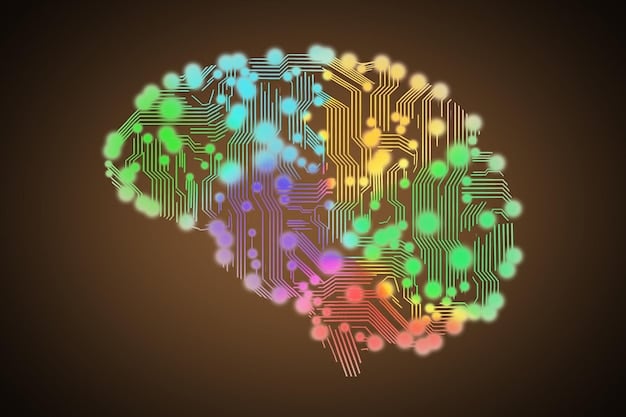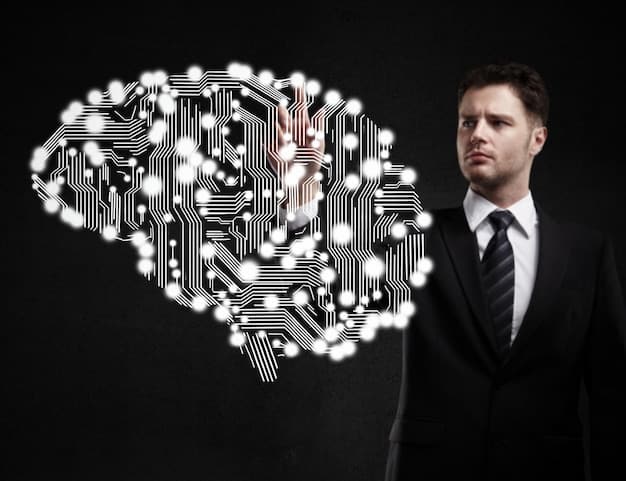Ethical Implications of AI in US Criminal Justice System

The integration of artificial intelligence into the US criminal justice system raises profound ethical concerns regarding fairness, bias, transparency, accountability, and human oversight, necessitating careful consideration and robust regulatory frameworks to uphold fundamental rights.
The burgeoning role of artificial intelligence within the US criminal justice system presents a complex tapestry of innovation and introspection. As AI continues its rapid ascent, integrating into areas from predictive policing to sentencing recommendations, the question of What are the Ethical Implications of AI in US Criminal Justice System? becomes not just academic but profoundly practical. This exploration delves into the nuanced ethical landscape AI carves within the pursuit of justice, examining both its promise and its peril.
The Rise of AI in Justice: A Double-Edged Sword
Artificial intelligence is swiftly transforming various facets of the US criminal justice system. From enhancing investigative capabilities to informing parole decisions, the allure of AI lies in its potential for increased efficiency and data-driven insights. However, this transformative power comes with inherent ethical challenges that demand meticulous scrutiny and thoughtful governance to ensure justice remains equitable and humane.
Proponents argue that AI can mitigate human biases, accelerating processes and potentially reducing crime rates through sophisticated predictive analytics. The promise is a system that operates with greater objectivity, unburdened by subjective human judgment. Yet, this vision is often challenged by the very nature of AI, which learns from historical data—data that may unfortunately reflect systemic inequalities and historical prejudices embedded within society and the justice system itself.
Predictive Policing and its Ethical Quagmire
Predictive policing, a key application of AI, utilizes algorithms to forecast where and when crimes are most likely to occur. While seemingly beneficial, this technology raises significant ethical questions concerning surveillance, profiling, and the potential for disproportionate targeting of certain communities. The data fed into these algorithms often reflects patterns of past policing, which have historically been skewed against minority groups.
- Bias Amplification: Algorithms trained on biased historical crime data can inadvertently perpetuate and even amplify existing racial and socioeconomic disparities in policing.
- Lack of Transparency: The proprietary nature of many predictive policing algorithms makes it difficult for the public and even legal professionals to understand how decisions are reached, fostering a lack of accountability.
- Erosion of Privacy: Extensive data collection required for predictive policing encroaches upon individual privacy rights, leading to concerns about surveillance states.
The ethical imperative here is to design and implement AI systems that are subjected to rigorous testing for bias, coupled with transparent methodologies, to prevent the unintended reinforcement of discriminatory practices. Without such safeguards, predictive policing risks becoming a tool for exacerbating social inequalities rather than addressing them.
Moreover, the concept of “pre-crime” inherent in predictive policing evokes dystopian narratives, where individuals are targeted not for actions committed, but for actions predicted. This shift from reactive to proactive law enforcement demands a re-evaluation of fundamental civil liberties and due process rights. The ethical dilemma centers on balancing public safety with individual freedoms, a balance that AI’s predictive capabilities can disrupt if not carefully managed.
Algorithmic Bias: The Unseen Threat to Fairness
Algorithmic bias is perhaps the most pervasive and insidious ethical concern surrounding AI in the criminal justice system. These biases are not intentional malice but rather a reflection of the data upon which AI models are trained. If historical crime data disproportionately reflects arrests and convictions among certain demographics, the AI will learn these patterns and replicate them, leading to potentially unfair outcomes.
Consider risk assessment tools used to inform bail, sentencing, and parole decisions. Algorithms like COMPAS (Correctional Offender Management Profiling for Alternative Sanctions) have been heavily criticized for their tendency to inaccurately label Black defendants as higher risk for recidivism than white defendants, even when controlling for similar prior offenses and criminal histories. This isn’t a deliberate bias by the algorithm developers, but a consequence of training data that reflects systemic biases in the human decisions that generated that data.
Sources and Manifestations of Bias
Bias can creep into AI systems at various stages, from data collection to algorithm design and deployment. Understanding these sources is crucial for developing strategies to mitigate their impact.
- Selection Bias: When the data used to train the AI does not accurately represent the population it will be applied to, or when certain groups are over- or under-represented.
- Measurement Bias: Occurs when the data being collected itself is flawed or unfairly measured. For instance, if certain neighborhoods are more heavily policed, leading to more arrests, the data will suggest higher crime rates in those areas, even if overall crime levels are comparable elsewhere.
- Algorithmic Bias in Design: Even well-intentioned algorithms can inadvertently incorporate biases if the criteria for “risk” are based on proxies that correlate with protected characteristics, like zip codes or socioeconomic status.
The ethical implications here are profound: AI, meant to be objective, can entrench and even amplify human biases, leading to discriminatory outcomes that erode public trust in the justice system. Addressing algorithmic bias requires transparent data collection practices, rigorous auditing of algorithms for disparate impact, and the development of fair AI principles that prioritize equity over mere efficiency. The challenge is not just technical but deeply societal, demanding a commitment to confronting systemic biases.

Transparency and Explainability: Demystifying the “Black Box”
One of the most significant ethical hurdles for AI in criminal justice is the “black box” problem. Many advanced AI systems, particularly those based on deep learning, operate in ways that are opaque even to their designers. Their decision-making processes are not easily deciphered or explained, making it challenging to understand why a particular outcome was reached.
In a justice system founded on principles of due process, accountability, and the right to understand accusations, this lack of transparency is deeply problematic. How can a defendant challenge a risk assessment score if neither they nor their lawyer can comprehend the factors that contributed to it? How can public confidence be maintained if critical decisions about liberty and justice are made by inscrutable algorithms?
The Right to Explanation
The ethical argument for transparency mandates that AI systems used in justice be explainable. This doesn’t necessarily mean understanding every line of code, but rather being able to articulate the key factors and reasoning behind an AI’s decision in a human-understandable way. The European Union’s General Data Protection Regulation (GDPR) has introduced a “right to explanation” for decisions made by automated systems, a concept that is gaining traction globally and is highly relevant to US criminal justice.
- Accountability: Transparent AI allows for auditing and oversight, making it possible to identify and rectify errors or biases within the system.
- Fairness: Explanations empower individuals to understand and challenge decisions that affect their lives, upholding their right to due process.
- Public Trust: A justice system that operates with transparency, even when employing complex technologies, fosters greater public confidence and legitimacy.
Achieving explainability in complex AI models is an active area of research, but ethical considerations demand that progress in this field keep pace with AI deployment. Without clear explanations, AI risks undermining the fundamental tenets of justice, transforming it into an unpredictable and potentially arbitrary process driven by unseen forces. The ethical imperative is to ensure that technological advancement does not come at the cost of accountability and human understanding.
Accountability and Responsibility: Who is Liable?
When an AI system makes an erroneous or biased decision that leads to a wrongful conviction, an unfair sentence, or even harm, who bears the responsibility? This question of accountability is complex, as AI systems are not legal persons capable of being held liable. Is it the developer who coded the algorithm, the company that sold it, the agency that purchased and deployed it, or the judge who relied on its output?
The traditional legal frameworks are not always well-suited to addressing the unique challenges posed by AI. The chain of causality from algorithm to outcome can be convoluted, making it difficult to pinpoint responsibility. This ambiguity can lead to a “responsibility gap,” where harmful outcomes occur without a clear avenue for redress or learning.
Establishing Clear Lines of Responsibility
Addressing this ethical vacuum requires new legal and ethical frameworks that clearly define responsibility for AI operations within the justice system. This might involve:
- Developer Liability: Holding AI developers responsible for ensuring their algorithms are fair, robust, and free from identifiable biases.
- Agency Accountability: Requiring criminal justice agencies to conduct rigorous internal reviews and audits of AI systems, ensuring they are used appropriately and with human oversight.
- Judicial Oversight: Emphasizing that judges retain ultimate responsibility for decisions, even when informed by AI. AI should be a tool, not a replacement for human judgment.
The ethical framework here demands that AI be treated as an assistive technology, not an autonomous decision-maker. Human oversight and ultimate human accountability must remain paramount. Without clear lines of responsibility, the deployment of AI could lead to a system where errors are normalized, and individuals are left without recourse, severely undermining the principles of justice and fairness.
Furthermore, the ethical implications extend to the potential for AI system failures. If an AI system has a catastrophic bug or is maliciously tampered with, the consequences in a criminal justice context could be devastating, leading to widespread miscarriages of justice. Therefore, robust security measures, regular integrity checks, and clear protocols for addressing system failures are not merely technical requirements but fundamental ethical obligations.
Human Oversight and the Erosion of Discretion
While AI offers efficiency, there’s a delicate balance to be struck with human oversight. An over-reliance on AI can lead to the erosion of human discretion, judgment, and empathy—qualities that are indispensable in a just legal system. The nuanced complexities of individual cases, the human element of rehabilitation, and the subjective nature of justice itself cannot be fully captured by algorithms.
When human actors like judges, prosecutors, and parole officers defer too heavily to algorithmic recommendations, they risk becoming mere executors of machine-generated decisions, rather than thoughtful arbiters of justice. This diminishes the role of human empathy and individualized consideration, potentially leading to a more rigid and less adaptable system.
Maintaining the Human Element
The ethical imperative is to ensure that AI serves as a valuable tool to assist human decision-makers, rather than replacing them. This requires clear guidelines and training for justice professionals on how to interpret and critically evaluate AI outputs. Strategies include:
- Auditability and Review: Implementing mechanisms for human review and override of AI recommendations, ensuring that algorithmic outputs are not accepted blindly.
- Training and Education: Educating legal professionals about the capabilities and limitations of AI, including potential biases and the “black box” problem.
- Emphasis on Discretion: Reinforcing the importance of human judgment and discretion in legal decision-making, ensuring that AI tools enhance, rather than replace, this crucial element.
The ethical challenge lies in preventing the “automation bias,” where humans are overly trusting of automated systems, even when their outputs are questionable. A justice system that fully integrates AI must also invest in strengthening the human capacity to critically engage with these technologies, ensuring that the scales of justice remain balanced by human wisdom and compassion. The goal is to leverage AI’s strengths while preserving the irreplaceable value of human insight and empathy.

Data Privacy and Security: Guardians of Sensitive Information
The implementation of AI in the criminal justice system inherently involves the collection, processing, and analysis of vast amounts of sensitive personal data. This includes criminal records, demographic information, behavioral patterns, and potentially even biometric data. The ethical implications surrounding data privacy and security are paramount, as breaches or misuse of this information could have catastrophic consequences for individuals and society.
Trust in the justice system relies significantly on the assurance that personal data will be handled responsibly and securely. Any compromise of this data could lead to identity theft, discrimination, unwarranted surveillance, and a chilling effect on civil liberties. Therefore, stringent data protection protocols are not merely regulatory requirements but fundamental ethical obligations.
Ensuring Robust Data Management
Addressing privacy and security concerns requires a multi-faceted approach that prioritizes data protection throughout the AI lifecycle. Ethical considerations demand:
- Data Minimization: Collecting only the data strictly necessary for the intended purpose, reducing the risk exposure.
- Anonymization and Pseudonymization: Implementing techniques to obscure individual identities, especially in training datasets, to protect privacy.
- Strong Encryption and Access Controls: Employing state-of-the-art security measures to protect data at rest and in transit, limiting access only to authorized personnel.
- Regular Audits and Compliance: Conducting routine security audits and ensuring strict adherence to data protection regulations like GDPR and state-specific privacy laws.
The ethical framework for AI in justice must integrate a robust data governance model that protects individuals from unwarranted intrusions and potential misuse of their information. This commitment to data privacy and security is crucial for building and maintaining public trust, ensuring that the benefits of AI do not come at the expense of fundamental rights. The sensitive nature of criminal justice data elevates these concerns, making privacy and security non-negotiable ethical pillars.
Moreover, the ethical implications extend to the potential for data aggregation and linkage, creating comprehensive profiles of individuals that could be used beyond the justice system’s intended purposes. Safeguards against such “scope creep” are essential to prevent the erosion of privacy and the creation of systems that could facilitate pervasive surveillance. The commitment to ethical data practices must be unwavering, preserving both individual rights and societal trust.
Looking Ahead: Towards Ethical AI in Justice
The integration of AI into the US criminal justice system is inevitable, given its potential to enhance efficiency and provide data-driven insights. However, the journey towards a truly beneficial and equitable integration is fraught with significant ethical considerations. The discussions around bias, transparency, accountability, human oversight, and data privacy are not peripheral concerns but central pillars upon which AI’s ethical deployment must be built.
To navigate this complex landscape, a multi-stakeholder approach is essential. This includes policymakers, legal professionals, AI developers, civil rights advocates, and the public, all collaborating to establish comprehensive ethical guidelines and regulatory frameworks. It requires continuous monitoring, evaluation, and adaptation of AI systems to ensure they align with the fundamental principles of fairness, justice, and human rights.
The ethical adoption of AI in criminal justice demands a proactive stance, prioritizing human values over mere technological prowess. It means investing in research to develop less biased algorithms, promoting education to ensure human oversight is effective, and creating transparent mechanisms for accountability. The future of justice, empowered by AI, must be one that reinforces, rather than jeopardizes, our core societal values.
| Key Ethical Concern | Brief Description |
|---|---|
| 🤖 Algorithmic Bias | AI trained on biased data can perpetuate or amplify existing systemic discrimination in justice outcomes. |
| 🕵️♂️ Lack of Transparency | “Black box” AI systems hinder understanding of decision-making, challenging due process and accountability. |
| ⚖️ Accountability Gap | Unclear responsibility when AI errors lead to unjust outcomes, making redress difficult. |
| 🔒 Data Privacy & Security | Extensive use of sensitive data raises concerns about breaches, misuse, and surveillance. |
Frequently Asked Questions about AI in US Criminal Justice
▼
Algorithmic bias refers to systematic and repeatable errors in a computer system that create unfair outcomes, such as favoring or disfavoring certain groups of people. In criminal justice, it often arises when AI is trained on historical data that reflects past human biases, leading to discriminatory predictions or recommendations, for example, regarding recidivism or sentencing.
▼
Transparency, often called “explainability,” is crucial because individuals have a right to understand decisions affecting their lives, especially in legal contexts. If AI decisions are a “black box,” it’s impossible to challenge errors, understand the reasoning, or ensure fairness. This lack of clear insight erodes public trust and undermines principles of due process.
▼
Currently, AI cannot fully replace human judges or lawyers. While AI excels at processing large datasets and identifying patterns, it lacks empathy, critical human judgment, and the ability to understand nuanced social contexts crucial for complex legal decisions. AI should function as a tool to assist, not replace, human professionals, maintaining essential human oversight and discretion.
▼
Primary privacy concerns include the vast collection of sensitive personal data, potential for data breaches, and the risk of this information being misused or improperly shared. There are also worries about pervasive surveillance and the creation of detailed individual profiles without consent, which could lead to discrimination or unwarranted scrutiny beyond criminal justice purposes.
▼
Ensuring ethical AI use requires a multi-faceted approach: developing clear regulatory frameworks, implementing rigorous bias testing, ensuring algorithmic transparency, maintaining strong human oversight, and upholding robust data privacy and security standards. Continuous auditing, public discourse, and interdisciplinary collaboration are vital to adapt as AI technologies evolve.
Conclusion
The ethical implications of AI in the US criminal justice system are profound and multifaceted, touching upon fundamental tenets of fairness, justice, and human rights. While AI offers compelling opportunities for efficiency and data-driven insights, its integration mandates meticulous attention to inherent risks such as algorithmic bias, lack of transparency, challenges in accountability, potential erosion of human discretion, and significant data privacy concerns. Navigating this evolving landscape requires a commitment to proactive governance, robust oversight, and continuous adaptation to ensure that technological advancements serve to enhance, rather than compromise, the integrity and equity of our legal system. The ultimate goal must be the development of AI solutions that are not only technologically sophisticated but also ethically sound, fostering a justice system that is truly fair, impartial, and respectful of individual liberties for all.





